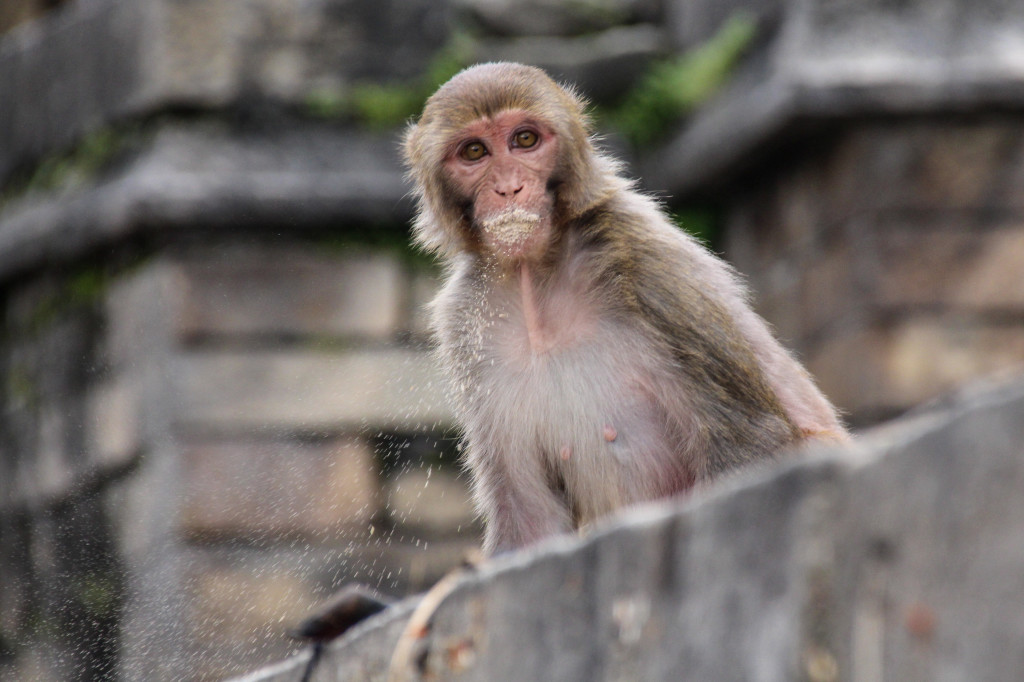Visitors to temples throughout Nepal may find themselves overwhelmed by dramatic, ancient architecture, drifting curls of incense, and the ticking of prayer wheels spinning. However, no Nepali temple experience would be complete without yet one more element: monkeys.
Accustomed to free handouts from temple visitors, these monkeys have free reign of many temples throughout Nepal. Their role in ancient Hindu mythology has earned them the title of “holy,” and therefore temples throughout Asia have become a safe haven and choice real estate for thousands of monkeys. Vistors often find these furry creatures to be cute and entertaining, but also mischievous.

Holy Monkeys
Hindu mythology describes Hanuman as the god of power and strength, known best for his loyalty to Rama, the seventh reincarnation of Vishnu. Monkeys who live within temples throughout Asia are believed to be his descendants and are viewed as holy monkeys.
Rebecca Kreston, author of Hanuman’s Bite: Temple Monkeys & Pathogen Swapping, describes monkeys’ role in Hindu mythology as, “the trickster of Hindu mythology, the mischievous troublemaking deity with a heart of gold and a glint in his eye.”
Troublesome
Mathilde Fuquinua, a French tourist, was enjoying an afternoon snack in an open-air coffee shop outside the Changu Narayan temple when a monkey charged across the restaurant, boldly jumped into the empty chair beside her, and grabbed her bag of pastries.
Fuquinua did not give up easily. After a brief game of tug-o-war, the monkey got away with all but one muffin.
“After the incident, I was very excited,” she described. “It was a impulsive gesture after the theft of my cheese pastry. The pressure was very high in myself, and it took some times to calm me down.”
While Fuquinua’s game of tug-o-war affectively allowed her to maintain possession of one muffin, it was a risk. Many times, similar interactions have led to more aggression from the monkey, and result in bites and scratches.
“The interspecies contact between us humans and the macaques is intimate, and bites and scratches are highly common – yes, yes, they are indeed biting the hand that feeds. Within local populations, worshippers, temple workers, nuns and monks, and market workers, the contact may be frequent and habitual,” writes Kreston in Discovery Magazine.
Health Risks
“I was at Pashipatinath and was minding my own business when a monkey, from out of no where, jumped from a nearby wall onto my head and then off to the wall across the road,” describes Amelia Abernathy, an American tourist. “It was like he was using me as a stepping stone!”
“I was shocked at first and didn’t realize what had happened, but when I put two and two together I started screaming,” she recalls. She then ran to her friends, who thoroughly searched her scalp for any cuts, fearing disease. “Meanwhile the monkey was sitting happily on the wall watching the aftermath of his assault unfold,” she describes with a laugh.
Disease is a valid concern, as it is common among most troops of temple monkeys. Of over 400 monkeys at Swayambhunath, most have been exposed to and carry disease.
Safety Precautions
Fuquinua and Albany ‘s stories are not uncommon. Many visitors have their share of monkey stories from Swayambunath, Pashipatinath, and many other temples throughout Asia.
Visitors to temples are encouraged to take safety precautions while around monkeys:
- Avoid making eye contact with monkeys
- Don’t smile at the monkeys, as showing your teeth is a sign of aggression for monkeys.
- Don’t feed the monkeys
- Don’t show fear
- Wear covering clothing to ensure they do not receive scratches from monkeys
- Don’t allow food items to be visible to the monkeys.
Not all monkey situations can be avoided, but following these basic guidelines within temples can help visitors avoid some monkey business.
